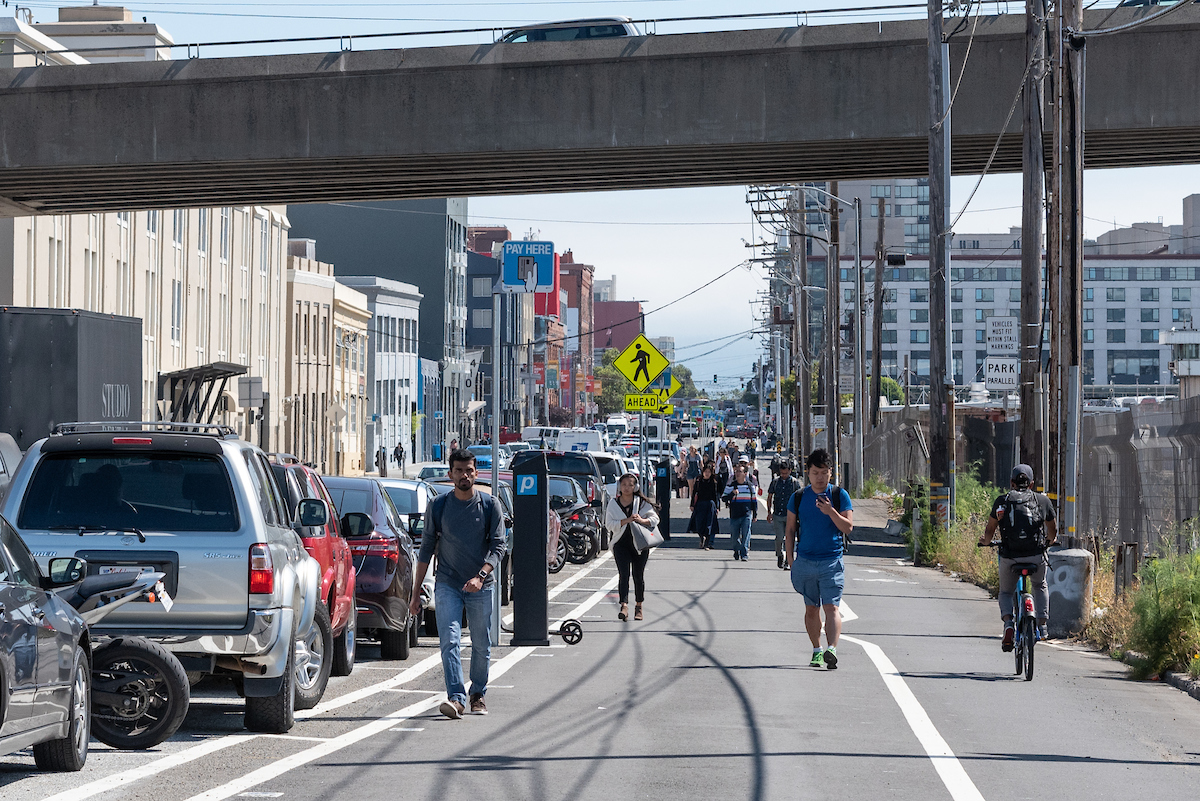Safe Streets 2019 Year End Report
The Results Are In!
Over the course of 2019, the SFMTA implemented a record number of walking, bicycling and traffic calming projects. Our goal is not only to deliver projects, but to make our streets safer and more comfortable for all San Franciscans. SFMTA’s Safe Streets Evaluation Program’s annual Safe Streets Evaluation Report takes stock of last year’s progress as well as lessons learned.

People walking and bicycling using the bike lane and pedestrian walkway along Townsend Street in June 2019.
Under the direction of Mayor London Breed, the SFMTA initiated the Vision Zero Quick-Build Program. This program represented reduced barriers for SFMTA to install pedestrian and bicycle safety improvements on the city’s High Injury Network, the corridors where high numbers of people have been killed and severely injured in traffic crashes.
Quick-Build projects offer opportunities to take community feedback in real time and make design changes as needed. These projects can be put in the ground in as little as 10% of the time and cost of our traditional infrastructure projects, such as Masonic Avenue and 2nd Street.
A key part of the Quick-Build Program is evaluating these fast-tracked projects so we can make the adjustments as we learn more. This report reviews some completed Quick-Build projects such as 7th Street Quick-Build Safety Project, 6th Street Pedestrian Safety Project and Safer Taylor Street .
In addition to Quick-Build projects, the effectiveness of dozens of citywide safety measures and corridor projects were also evaluated.
Overwhelmingly, clear safety benefits are provided by Quick-Builds, traditional corridor projects and citywide countermeasures completed in 2019:
- Corridor-long safety projects for people walking reduce vehicle speeds and provide improved loading experiences.
- Proactive, neighborhood-wide traffic calming leads to reduced vehicle speeds on the city’s residential streets.
- Protected bike lanes decrease how often bike lanes are blocked, and nearly eliminate mid-block vehicle-bike conflicts such as near-dooring incidents.
- Bike traffic signals that are separate from traffic signals for other vehicles reduce conflicts between turning vehicles and people bicycling in protected lanes.
- Through surveying, we heard from community members from different demographic backgrounds that new and improved bicycle and pedestrian facilities make people feel safer and more comfortable.
Just as importantly, we are also learning what doesn’t work:
- Large capital projects should be accompanied by quick-build efforts to implement changes as soon as possible, as large capital streetscape projects have long timelines and high price tags.
- Partially raised bikeways, especially on commercial corridors, have issues including the bike lane being blocked by stationary vehicles. And to this end, partially raised bikeways do not provide enough of a barrier to deter cars from the bike lane.
- We need more reporting on equity metrics. While we improved our survey methods and techniques to better represent a wider demographic and socio-economic range of users, our program must go further. We need metrics that specifically measure equity and inclusivity through the process through implementation.
What’s Next?
Given the many changing parts of the social and physical infrastructure in 2020, our pedestrian and bicycle safety efforts will need to be evaluated, analyzed and assessed in very different ways than previous years. We are considering new evaluation goals to understand what works on our streets within the context and unique characteristics of the coronavirus pandemic and the intersecting racial equity movement.
